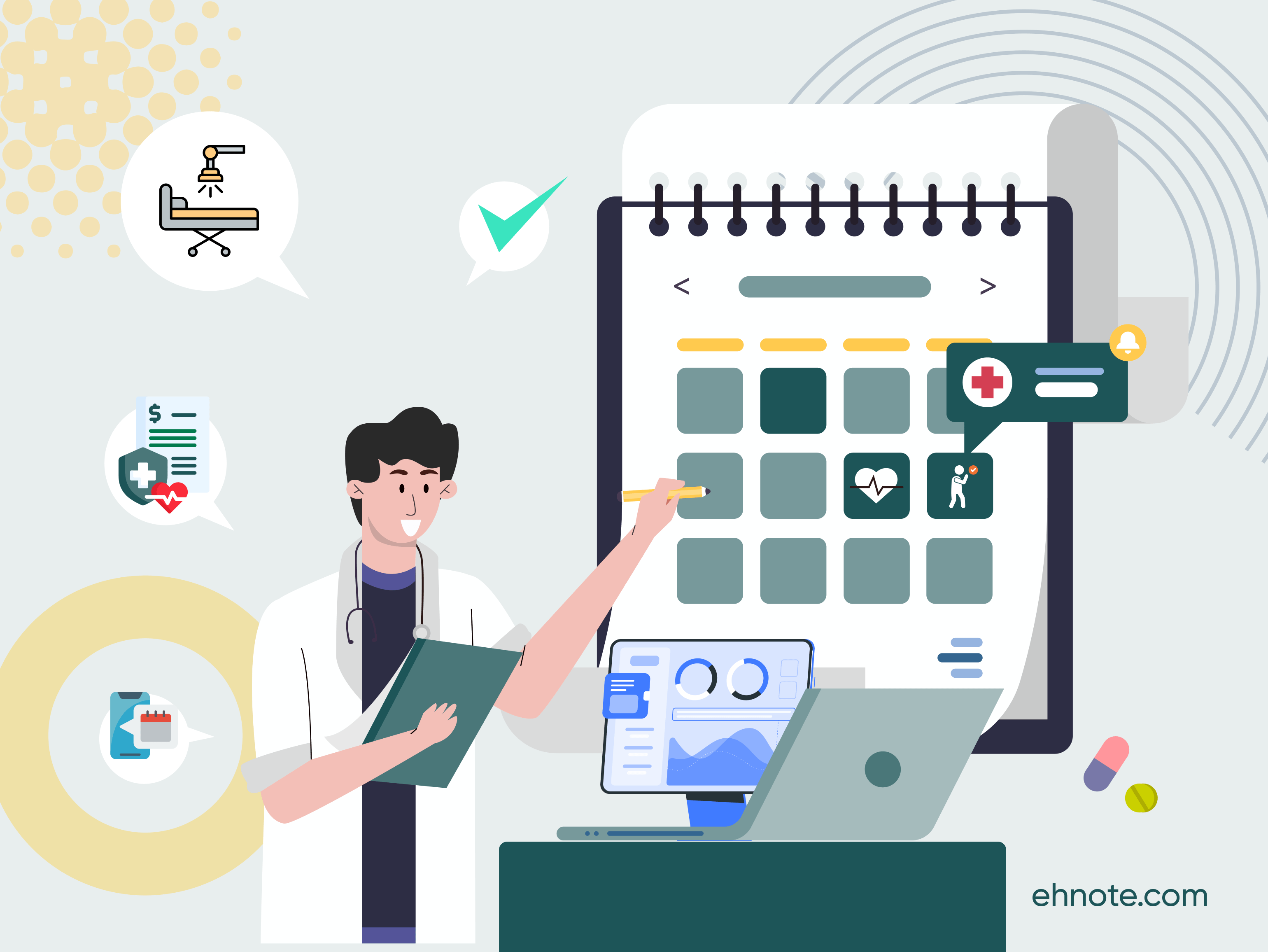14 Must-Have Features in Your Patient Scheduling Software

Imagine this: You get started in the morning, and your clinic is bustling with activity. Patients are lining up, phones are ringing off the hook, and your staff is juggling appointment schedules, cancellations, and new bookings. Amid this chaos, your Patient Scheduling Software crashes, leaving everyone frustrated and overwhelmed. Sound familiar?
Many healthcare providers face this daily struggle. But what if there was a way to simplify the scheduling process, reduce no-shows, and make life easier for both staff and patients?
That’s Right, an Integrated and Modern Patient Scheduling Software! Let's explore the top features you should look for to ensure your software is up to the task.
1. Ophthalmology Specific Scheduling
For practices specializing in ophthalmology, having ophthalmology-specific scheduling is crucial. This feature allows you to select the type of visit such as a physical consultation or a tele appointment and the reason for the appointment, providing the doctor with advance knowledge to tailor the patient's journey accordingly. This ensures a more personalized and efficient patient experience.
2. Intuitive User Interface
First and foremost, the software must be easy to use. An intuitive user interface means that your staff can quickly learn the system without extensive training. Look for drag-and-drop functionality, clear navigation, and simple, visually appealing design. This will minimize errors and speed up the scheduling process.
3. Real-Time Appointment Booking
In today’s fast-paced world, real-time appointment booking is a must. This feature allows patients to see available time slots and book appointments instantly. It reduces the back-and-forth communication and helps fill up your schedule more efficiently. Plus, it offers convenience for patients, who can book appointments at any time.
4. Office and ASC Appointments
A versatile Patient Scheduling Software should handle both office and Ambulatory Surgery Center (ASC) appointments. This flexibility ensures that all types of visits can be managed within one system, providing a seamless scheduling experience for both staff and patients.
5. Insurance Eligibility Checking
Insurance Eligibility Checking is a vital feature that saves time and reduces billing errors. It allows your staff to verify a patient's insurance coverage before their appointment, ensuring there are no surprises or delays in treatment. This helps maintain a smooth financial process for both the practice and the patient.
6. Patient Self-Scheduling
Empower your patients by allowing them to book their own appointments through patient Self-scheduling Software. This feature gives patients control over their healthcare and reduces the workload on your administrative staff. Ensure that the software integrates seamlessly with your website or patient portal for a smooth experience.
7. Digital Patient Check-In System
Say goodbye to paper forms and long wait times with a digital patient check-in system. This feature enables patients to check in using a tablet or kiosk, update their information, and complete necessary forms digitally. It streamlines the process, reduces errors, and allows your staff to focus on more critical tasks.
8. Automated Reminders and Notifications
One of the biggest challenges in any practice is reducing no-shows. Automated Reminders via email, SMS, or phone call can significantly decrease missed appointments. Your Patient Scheduling Software should send reminders a few days before the appointment and on the day itself. This feature not only improves attendance but also enhances patient satisfaction.
9. Pre-Consultation Forms
Streamline the virtual patient consultation process with pre-consultation forms. This feature allows patients to fill out necessary forms before their virtual session, reducing wait times and ensuring the doctor has all the required information beforehand. It improves the overall patient experience and allows for more efficient use of appointment time.
10. Queue Management
Efficiently managing patient flow with queue management features is essential for any busy practice. This feature helps organize and prioritize patient visits, reducing wait times and enhancing the overall patient experience. It ensures that the clinic operates smoothly, even during peak hours.
11. Patient Tracking
Tracking the patient's journey within the clinic can enhance overall efficiency. This feature allows staff to monitor where patients are in their visit, reducing wait times and ensuring a smooth flow from check-in to check-out. It helps in managing resources effectively and improving patient satisfaction.
12. Smart Waiting List
A waitlist management feature lets you add patients to a waitlist and automatically notify them if an earlier slot becomes available. This keeps your schedule full and accommodates patients’ needs more efficiently. Additionally, it helps practices overcome revenue loss from no-shows by filling gaps with waiting list patients in real-time.
13. Comprehensive Reporting and Analytics
To run an efficient practice, you need to understand your data. Look for software that offers comprehensive Reporting and Analytics. This feature should provide insights into appointment trends, no-show rates, patient demographics, and more. With this information, you can make data-driven decisions to improve your practice.
14. Integration with Other Systems
Your Scheduling Software should seamlessly integrate with other systems you use, such as Electronic Health Records (EHR), billing systems, and referral portals. This integration ensures a smooth flow of information, reduces manual data entry, and minimizes errors.
Bringing It All Together
Choosing the right Patient Scheduling Software involves considering many factors but focusing on these top 14 features will set you on the right path. A user-friendly interface, patient self-scheduling, and a digital patient check-in system enhance the overall patient experience and streamline your practice’s operations. Automated appointment reminders and integration with EHR/EMR systems keep everything running smoothly, while mobile accessibility ensures flexibility.
Customizable scheduling options and a robust Patient Portal improve patient engagement and satisfaction. Reporting and analytics provide the insights you need to optimize your practice, and strong security and compliance measures protect patient data and maintain trust.
By prioritizing these features, you’ll be well on your way to selecting Patient Scheduling Software that meets your needs and helps your practice thrive. So, take the time to evaluate your options, and soon enough, you’ll wonder how you ever managed without it!
Start Your Search Today
Investing in the right Patient Scheduling Software can transform the way your practice operates. From enhancing patient satisfaction to boosting efficiency, the benefits are immense. By considering these top features, you can choose a system that meets your needs and supports your practice's growth.
Now that you know what to look for in Patient Scheduling Software, it’s time to start your search. There are many options out there, so take your time to find the one that fits your practice’s unique needs. With the right software in place, you’ll see improvements in efficiency, patient satisfaction, and overall practice management.
So, why wait? Upgrade your scheduling process today and experience the difference!
Get a Personalized Walk Through and Explore How a Robust and Reliable Patient Scheduling Software Helps Your Practice Thrive with Growing Traffic, Happy Patients, and Increased Revenue Generation!
FAQs
-
1. Why is patient scheduling software important for my practice?
Patient Scheduling Software streamlines the appointment booking process, reduces administrative workload, minimizes no-shows, and enhances patient satisfaction. It ensures more efficient and organized practice.
-
2. Can patients book their own appointments?
Yes, EHNOTE’s Patient Scheduling Software options include a patient self-scheduling feature, allowing patients to book appointments online at their convenience.
-
3. What kind of reminders does the software send?
Automated reminders can be sent via email or SMS or both, helping to reduce no-shows by reminding patients of their upcoming appointments.
-
4. How does waitlist management work?
Waitlist management allows you to add patients to a waitlist and automatically notify them if an earlier appointment becomes available, ensuring your schedule stays full and minimizing revenue loss from no-shows.
-
5. Can the software integrate with other systems?
Yes, EHNOTE’s Patient Scheduling Software integrates seamlessly with other systems like EHR, PMS, and referral portals to ensure a smooth flow of information.
